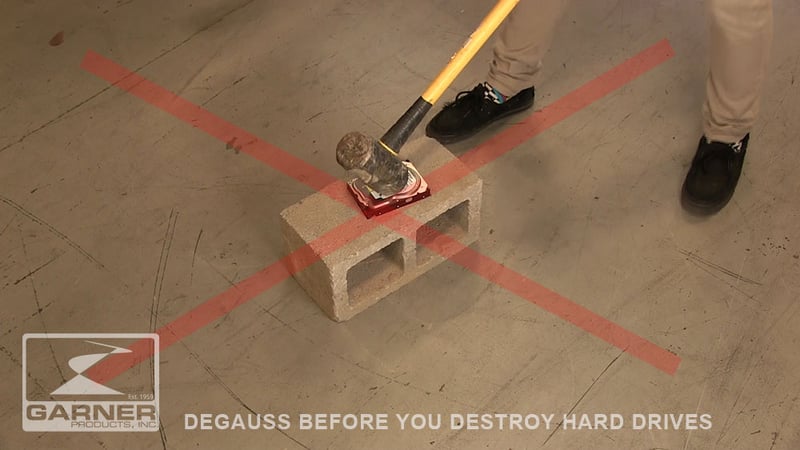Think the data is gone? Think again.
A data recovery story: “A Powerbook was trapped for two days in a sunken cruise ship at the bottom of the Amazon River. The owner grabbed their scuba gear and dove down to rescue it. DriveSavers recovered all the data.”
-DriveSavers Sunken Treasure from the Museum of Bizarre Disk-Asters
As the Sunken Treasure story demonstrates, the folks at DriveSavers have quite the repertoire of stories of data recovery. They retrieve data from computers and hard drives that have been burned, melted, crushed, mangled in earthquakes, and damaged in hurricanes.
Garner Products and our friends at DriveSavers appear to have opposing business objectives: DriveSavers recovers and restores data on hard drives through advanced laboratory techniques and Garner destroys data on hard drives with magnetic fields produced by their hard drive degaussers so that the data is forensically unrecoverable. So what is the synergy between the two companies? DriveSavers uses Garner degaussers to forever erase the data on their customers’ damaged hard drives after DriveSavers has recovered and transferred the data to a new hard drive. This underscores the need for a degausser to sanitize a hard drive of all data after the media has reached the end of its useful life. Otherwise, as DriveSavers proves daily, data recovery is very possible.
How does a hard drive work?
A hard drive is a storage device that magnetically stores data on disk platters inside a sealed case. Data is stored on the hard drive with magnetic fields that create what the computer reads as 1’s and 0’s and decodes them into meaningful data we see on our computer monitors. To fully sanitize a hard drive of data, you must remove the stored magnetic patterns (1’s and 0’s) from the hard drive. The fastest and most thorough way to achieve this is through degaussing. Degaussing erases data by removing these magnetic patterns and thus removes the data. A degausser applies an external magnetic field to the entire hard drive, erasing all data from the drive. With degaussing, the hard drive does not need to be working or properly functioning to achieve complete data sanitization.
What does it mean to sanitize a hard drive?
To sanitize a hard drive means to permanently and irreversibly destroy all the data on it. Data on a sanitized hard drive cannot be recovered, even through advanced forensic means. Hard drive sanitization ensures the data on decommissioned drives is safe from hackers, thieves, and any other unauthorized users.
What are ineffective ways to sanitize a hard drive that allow for data recovery?
As DriveSavers’ Museum of Bizarre Disk-Asters exemplifies, ineffective ways to sanitize a hard drive include:
- Burning it (unless you incinerate at temps greater than 670° C/1,238° F)
- Submersing it in water
- Throwing it down a 26-story building
- Running it over with a car
DriveSavers have successfully recovered data from devices that have undergone all of these catastrophic events.

What are effective ways to sanitize a hard drive to prevent data recovery?
You can incinerate a hard drive at temps greater than 670° C and the data on the drive will be unrecoverable. Even if you own a smelter, this process is dangerous, messy, and toxic.
The best way to sanitize a decommissioned hard drive is to degauss it. Degaussing (demagnetizing) applies a strong magnetic field to the drive which overcomes its coercivity (resistance to being erased). Since the data is a magnetic field, clearing the magnetic field eliminates the data.
Most current magnetic hard drives data platters have a coercivity of 5,000 oersteds. What does this mean? It means that you would theoretically need a magnetic field of 5,001 oersteds/gauss to erase the data. Essentially, one gauss demagnetizes one oersted. Garner degaussers generate between 10,000 and 20,000 gauss, well above the coercivity rating of the hard drive. A degaussed hard drive contains no magnetic patterns, meaning there is no data and the drive is completely safe to be recycled or disposed of.
With a Garner degausser, the degaussing process is simple. You turn the degausser on and put the hard drive in the media drawer. Closing the drawer automatically starts the degauss cycle. In just seconds, the data is sanitized. Because degaussing destroys the data but leaves the media housing intact, the drive is recyclable for its components. The degaussing process is environmentally friendly, as there are no toxic byproducts that result.
So what’s the takeaway?
DriveSavers’ customers feel relieved that their devices burned in housefires or pummeled by hurricanes still have recoverable data. However, you’d feel just the opposite to know that the hard drives you fruitlessly burned, submerged, or crushed to intentionally destroy data, can still contain recoverable data.
Don’t risk sensitive information falling into the wrong hands, degauss your end-of-life media.
Lost Data? Call DriveSavers Data Recovery • 24/7 • 1.800.440.1904 • Mention discount code DS98047
Source:
All About the Bizarre Disk-asters | DriveSavers (drivesaversdatarecovery.com)


LEAVE A REPLY